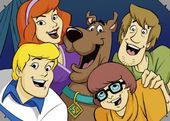
They found that animated shows aimed at youngsters often have more brutality than programmes broadcast for general audiences.
And they said children copied and identified with fantasy characters just as much as they would with screen actors.
Cartoons aimed at children, such as Scooby Doo, contain more brutality than programmes meant for general audiences, a study has found
The study also found that youngsters tended to mimic the negative behaviour they saw on TV such as rumour-spreading, gossiping and eye-rolling.
The U.S. psychologists quizzed 95 girls aged ten and 11 about their favourite TV shows, rating them for violent content and verbal and indirect aggression.
The shows included Lost, Buffy the Vampire Slayer, American Idol, Scooby-Doo and Pokemon.
The researchers found that output aimed at children as young as seven, which included a number of cartoons, had the highest levels of violence.
They recorded 26 acts of aggression an hour compared with just five in shows aimed at general audiences and nine in programmes deemed unsuitable for under-14s.
'Results indicated that there are higher levels of physical aggression in children's programmes than in programmes for general audiences,' the study said.
It added that the TV industry distinguished between animated violence and non-animated violence and appeared to rate the former as less harmful.
'There is ample evidence that animated, sanitised and fantasy violence has an effect on children,' the study's authors said.
'Research on the effects of violent video games, which are all animated, indicates that they have the same effects on children's aggressive thoughts, feelings and behaviours that violent TV shows have demonstrated.
'In fact, even cartoonish children's games increase aggression. Labelling certain types of media violence as "fantasy" violence is misleading and may actually serve to increase children's access to harmful violent content by reducing parental concern.'
The study, by academics at Iowa State University and published in the Journal of Applied Developmental Psychology, also found that children copied at school the verbal aggression they had seen on TV.
It said: 'In addition, the effects of televised physical aggression were extensive, such that exposure to televised physical aggression was associated with a variety of negative behaviours in girls.'
This anti-social behaviour included verbal and physical aggression and excluding others from friendship groups.
Co-author Jennifer Linder said: 'There is ample evidence that physical aggression on TV is associated with increases in aggressive behaviour, but there was little until this study that has shown a link between televised aggression and resulting aggression among children.'
Professor Douglas Gentile, who led the study, said content ratings on TV programmes should provide detailed information on the aggression shown.
The U.S. introduced a ratings system in the mid-1990s but the idea has not been picked up in Britain.




Who makes these cartoons?